In 2011, the White House announced big increases in CAFE fuel economy standards.
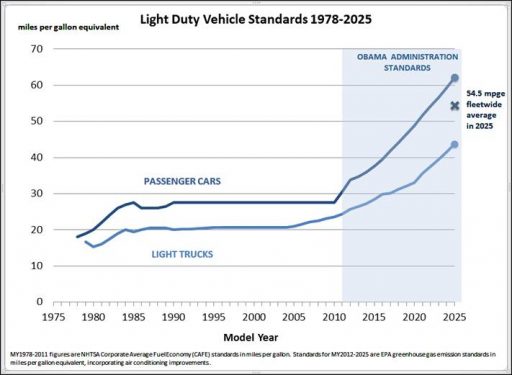
The result has been counterintuitive. But before looking at the outcome, let me correct a misconception. The chart above refers to the “fleetwide average” – but this is the new vehicle fleetwide average, not the average of vehicles on the road. Of course it is the latter that matters for CO2 emissions and other outcomes. The on-the-road average lags the standards by a long time, because the fleet turns over slowly, due to the long lifetime of vehicles. It’s worse than that, because actual performance lags the standards due to loopholes and measurement issues. The EPA puts the 2017 model year here:
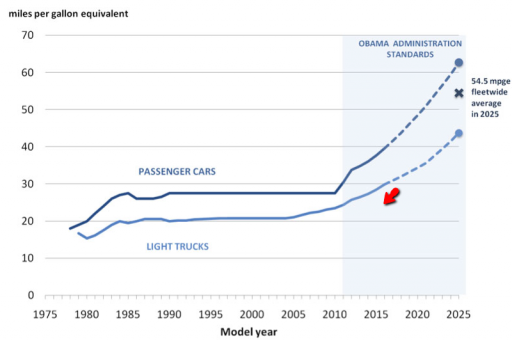
But wait … it’s still worse than that. Notice that the future fleetwide average is closer to the car standard than to the truck standard:
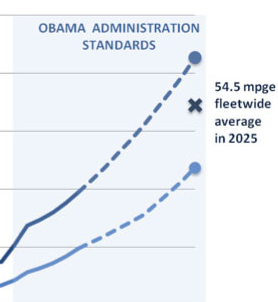
That implies that the market share of cars is more than 50%. But look what’s been happening:
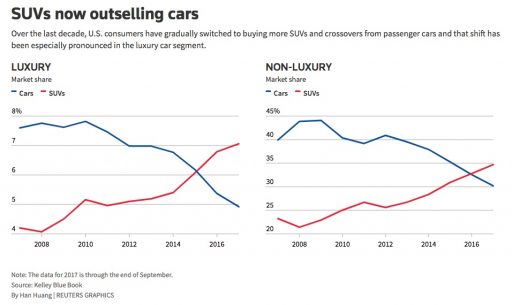
The market share of cars is collapsing. (If you look at longer series, it looks like the continuation of a long slide.) Presumably this is because, faced with consumer appetites guided by cheap gas and a standards gap between cars and trucks, automakers are doing the rational thing: they’re dumping their cars fleets and switching to trucks and SUVs. In other words, they’re moving from the upper curve to the less-constrained lower curve:
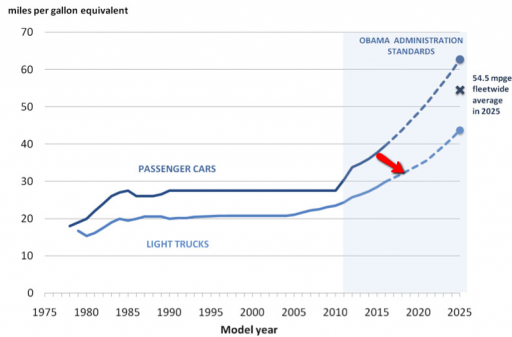
It’s actually worse than that, because within each vehicle class, EPA uses a footprint methodology that essentially assigns greater emissions property rights to larger vehicles.
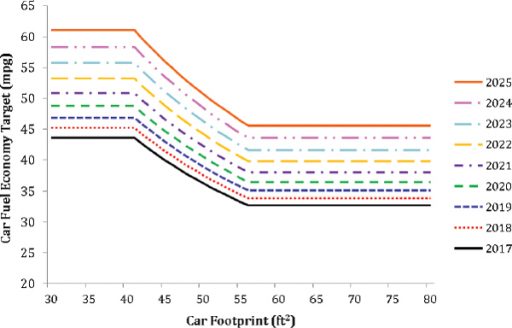
So, while the CAFE standards seemingly require higher performance, they simultaneously incentivize behavioral responses that offset much of the improvement. The NRC actually wondered if this would happen when it evaluated CAFE about 5 years ago.
Three outcomes related to the size of vehicles in the fleet are possible due to the regulations: Manufacturers could change the size of individual vehicles, they could change the mix of vehicle sizes in their portfolio (i.e., more large cars relative to small cars), or they could change the mix of cars and light trucks.
I think it’s safe to say that yes, we’re seeing exactly these effects in the US fleet. That makes aggregate progress on emissions rather glacial. Transportation emissions are currently rising, interrupted only by the financial crisis. That’s because we’re not working all the needed leverage points in the system. We have one rule (CAFE) and technology (EVs) but we’re not doing anything about prices (carbon tax) or preferences (e.g., walkable cities). We need a more comprehensive approach if we’re going to beat the unintended consequences.

As predicted, years ago:
https://digitalcommons.wpi.edu/mqp-all/6010/
The system dynamics of automobile fuel economy
Catherine Anne Raposa, Worcester Polytechnic Institute
Todd K. BenDor, Worcester Polytechnic Institute
Faculty Advisor
Lyneis, James M.
Abstract
This project analyzes the dynamics of US automobile gasoline consumption since 1970. Through the creation of a System Dynamics computer model, we are able to understand historical trends and test several currently proposed policies. We conclude that when fuel efficiency development is not conducted in an environment with rising fuel costs, the development is directly counteracted by the shifting tastes of consumers towards larger automobiles with lower fuel efficiency.
h/t Christine Tang